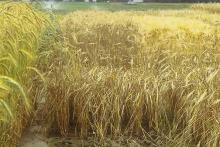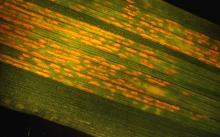See:
Fungicide Effectiveness as Seed Treatments for Cereal Diseases
Cause The fungus, Puccinia striiformis f. sp. hordei, is an obligate parasite that overwinters or oversummers on volunteer barley or rye, certain wild barleys such as Hordeum jubatum (foxtail barley), wheat, and numerous perennial grass species. Wet winters with mild temperatures or abundant snow cover favor pathogen survival. The disease begins from a very small number of infections that are difficult to detect in the field. Spread of the pathogen can be explosive and cause significant losses, especially in the Pacific Northwest where cool, wet weather greatly favors disease development.
Symptoms Linear, orange-yellow pustules appear on leaves and/or heads at any growth state after infection. Pustules coalesce to form long stripes between leaf veins. In advanced stages, entire leaf blades of susceptible varieties may be covered with pustules. The black spore stage develops as linear black pustules covered by the leaf epidermis.
Cultural control
- Use resistant varieties. The winter barleys 'Kold' and 'Strider' are resistant, and 'Hundred' may show somewhat reduced infection. Using varietal mixtures or multilines may slow the rate of epidemic buildup. Spring barleys with some resistant are available: 'Crest' and 'Orca' are two-row feed barley varieties developed by OSU; 'Tango' is a nondormant six-row; and 'Sara' is a six-row. 'Baronesse' has intermediate resistance and excellent yield potential. OSU has released the winterhooded barley 'Verdant' (a malting variety), which has some resistance.
- Plant winter varieties as late as possible and spring varieties as early as possible to help reduce the number of initial infections.
Chemical control Scout barley regularly for rust, looking at lower leaves first. If conditions are cool and wet, inspect one more time, just before flag emergence.
Apply fungicides if stripe rust severity is greater than 5% at the late tillering stage. Scout fields weekly from mid-tillering to flag leaf emergence.
- Demethylation-inhibiting (DMI) Fungicides (Group 3) are labeled for use.
- Bumper 41.8 EC or Bumper ES at 4 fl oz/A on a minimum of 14-day intervals for no more than two (2) applications, one (1) application maximum if harvesting for forage or hay. Do not apply within 45 days of harvest for grain and straw; 30 days for forage or hay. 12-hr reentry.
- Prosaro 421 SC at 6.5 to 8.2 fl oz/A at early flower (Feekes growth stage 10.5). Do not apply within 30 days of harvest. 12-hr reentry. Tebuzol 3.6F at 4 fl oz/A as a single application per season. Do not apply within 30 days of harvest. 12-hr reentry.
- Tilt at 4 fl oz on a minimum of 14-day intervals for no more than two (2) applications, one (1) application maximum if harvesting for forage or hay. Apply when the flag leaf is 50% to fully emerged, up to late head emergence (Feekes 10.5). Preharvest interval is 7 days for forage and and hay. 12-hr reentry.
- Topguard at 10 to 14 fl oz/A on 7-day intervals. Preharvest interval is 0 days for forage, 15 days for hay, and 30 days for grain.12-hr reentry.
- Regalia (Group P5) at 1 to 4 quarts/A on 7- to 10-day intervals starting prior to infection. Under high-disease pressure, use in combination with another fungicide. Does not benefit from the addition of an adjuvant. 4-hr reentry. O
- Strobilurin fungicides (Group 11) are labeled for use. Do not make more than one (1) application of any Group 11 fungicide per season.
- Headline at 6 to 9 fl oz/A. Apply no later than 50% head emergence (Feekes 10.3). Preharvest interval is 14 days for hay and forage. 12-hr reentry.
- Quadris Flowable at 9 to 12 fl oz/A applied prior to disease development, up to late head emergence (Feekes 10.5). Do not apply within 7 days of grazing. Preharvest interval is 7 days for forage and hay. 4-hr reentry.
Note: Premixed fungicides are available for use. Do not make more than one (1) application of any Group 11 fungicide before alternating to a labeled fungicide with a different mode of action.
- Miravis Ace (Group 3 + 7) at 13.7 fl oz/A. Apply between Feekes 10.3 and 10.5.4. Harvest interval is 7 days for forage and hay. 12-hr reentry.
- Priaxor (Group 7 + 11) at 4 to 8 oz/A. Do not apply after 50% head emergence (Feekes stage 10.3). Preharvest interval is 14 days for forage and chopped feed. 12-hr reentry.
- Quilt Xcel (Group 3 + 11) at 10.5 to 14 fl oz/A when the flag leaf is 50% to fully emerged. Applications may be made no closer than a 14-day interval and may be applied up to Feekes growth stage 10.5. Do not make more than two (2) applications per season. Preharvest interval is 7 days for forage and hay. 12-hr reentry.
- Stratego (Group 3 + 11) at 7 fl oz/A or Stratego YLD at 2.3 fl oz/A. Do not apply after flag-leaf emergence (Feekes stage 8). Do not make more than two (2) applications per season. Do not apply within 40 days of harvest. See label for grazing, forage, and hay restrictions. 12-hr reentry.
- Trivapro (Group 3 + 7 + 11) at 9.4 to 13.7 oz/A beginning when the flag leaf is 50% to fully emerged, up through full head emergence. Do not make more than two (2) sequential applications of Trivapro or other Group 7 or Group 11 fungicides. Preharvest interval is 7 days for forage and hay, 45 days for grain and straw. 12-hr reentry.
References Adams, E.B. 1997. Barley Stripe Rust. WSU Cooperative Extension Bulletin 1839.
Mathre, D.E. 1997. Compendium of Barley Diseases. St. Paul, MN: APS press.



